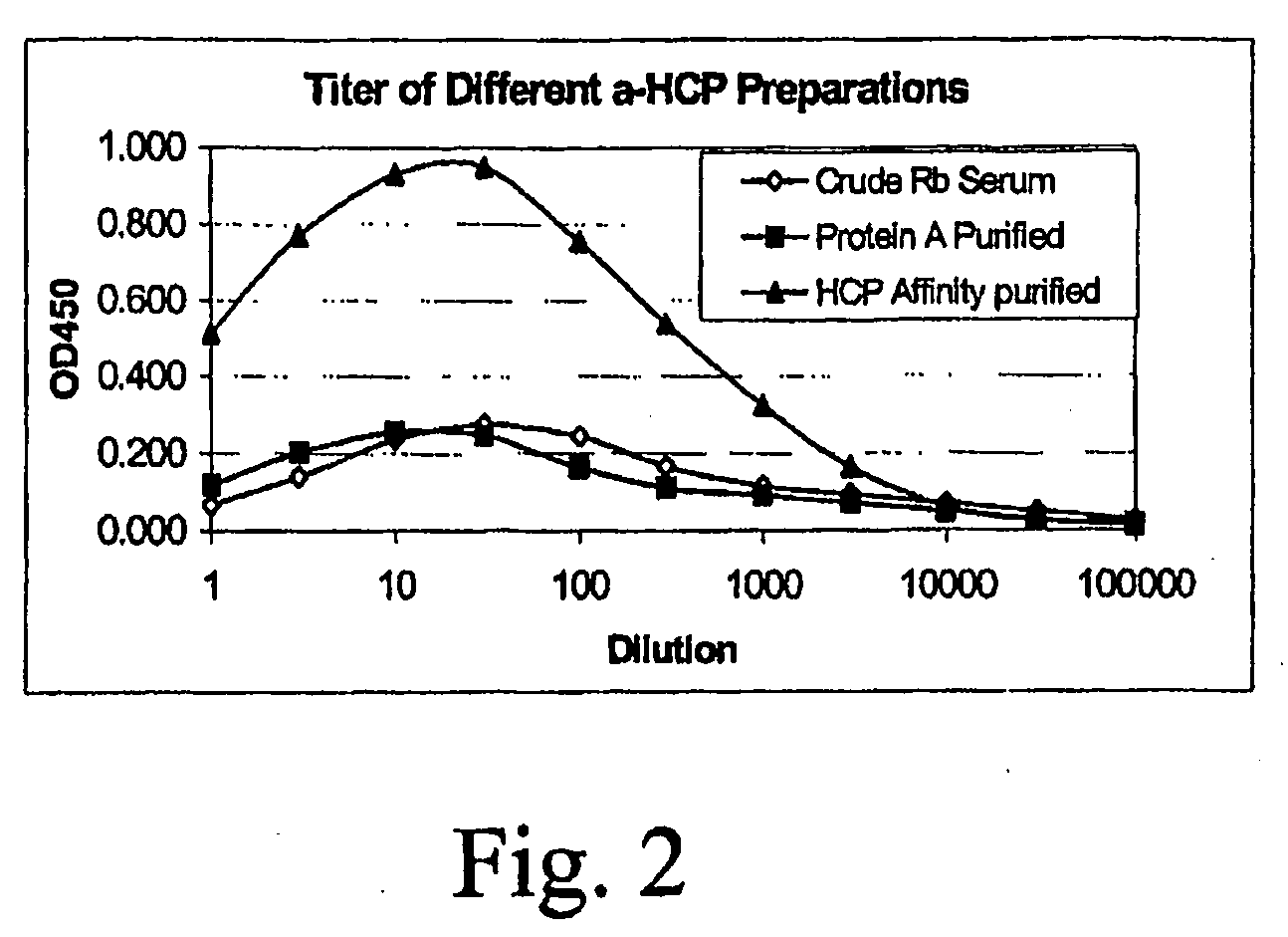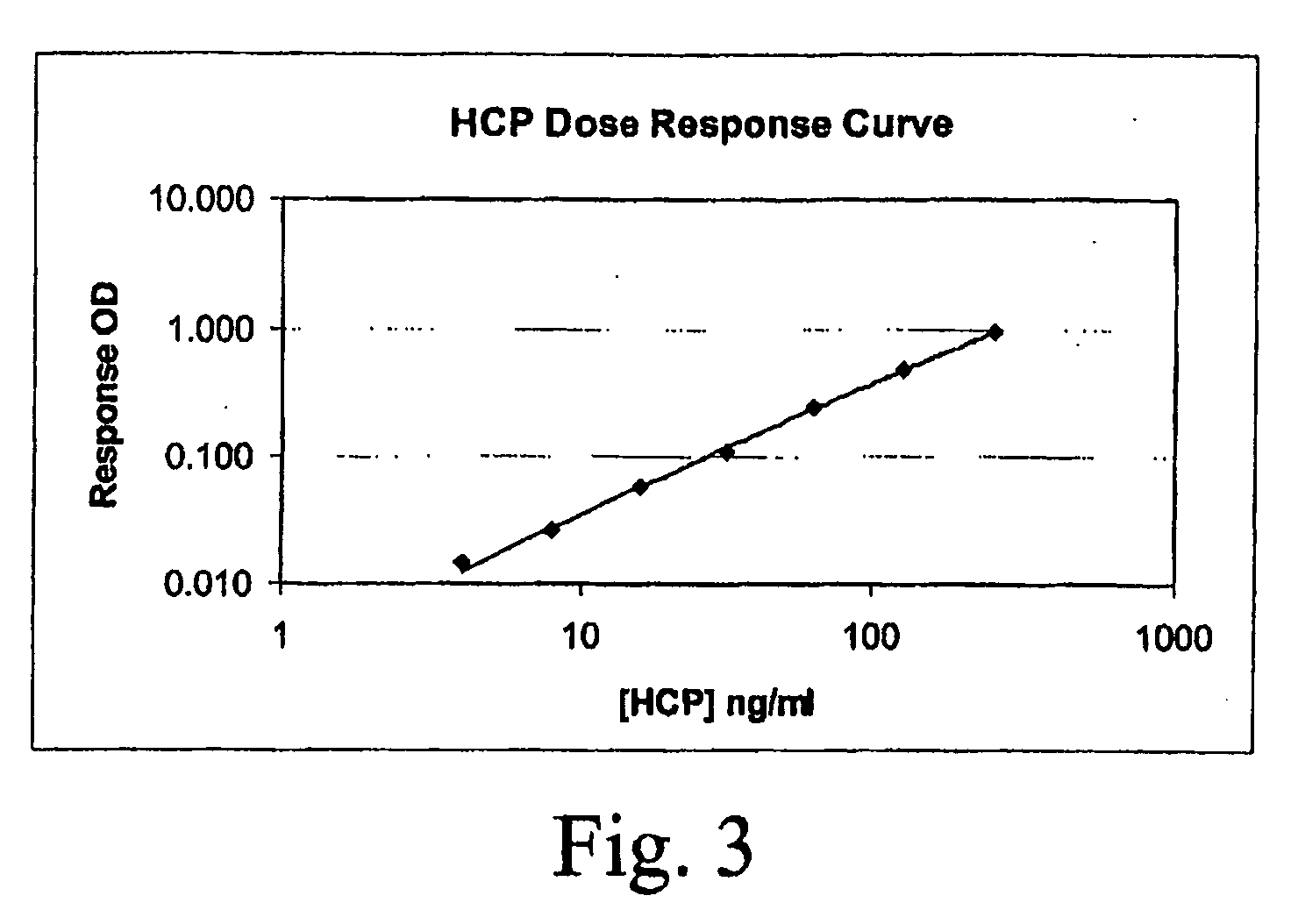Detecting and Quantifying Host Cell Proteins in Recombinant Protein Products
- Summary
- Abstract
- Description
- Claims
- Application Information
AI Technical Summary
Problems solved by technology
Method used
Image
Examples
example 1
HCP Pool (30) Production from Parental Cells (10)
[0039]Frozen parental cells were thawed, in a 37° C. water bath for an appropriate amount of time. The thawed cells were mixed, and an aliquot (i.e. 1 ml) of the cells taken and mixed with a pre-warmed growth medium (at about 37° C.). The ratio of the growth medium to the cell concentration was about 9:1. The cell culture was then centrifuged to form a cell pellet to better separate the cells from impurities. The cell pellet was re-suspended in a similar amount of growth medium. The cell culture was incubated at about 37° C. (i.e., about 90% humidity and about 5% CO2). The cell culture was transferred to a spinner flask, and after about 7 days to a bioreactor. Once the cells were ready to harvest, the cell culture was centrifuged and filtered using a 0.2 μm filter.
[0040]A BCA protein assay was performed to determine the total protein concentration. A well known BCA technique and kit uses a combination of working reagents, which are th...
example 2
Immunization (40)
[0051]The HCP pools (30) are then utilized for custom polyclonal antisera production. An example immunization treatment as discussed above and as produced in Example 2 is based on a seven-day routine.
[0052]The two HCP preparations, pools I and II in 10 ml aliquots, were subjected to custom polyclonal antisera production procedures. Two New Zealand White rabbits for each immunogen were used with a standard immunization protocol based on a seven-day routine. Animals were pre-bled on day 0. The initial injection (1 mg each) was administered subcutaneously in complete Freund's adjuvant (CFA) and all subsequent injections (every two weeks, 1 mg each) were in incomplete Freund's adjuvant (IFA). About 25 ml of sera were collected from each rabbit seven days after each boost. The titer from the first bleed was assessed using EIA. All of the rabbits exhibited good binding titers to the HCP immunogens (titer is defined as the antiserum dilution that produces a net OD of 1.0 i...
example 3
HCP Affinity Chromatography (75)
[0054]As mentioned above, the crude polyclonal anti-HCP antibodies produced from the sera are purified using HCP affinity chromatography. The affinity media includes HCPs from the initial HCP pool (30) that were coupled to beads. The HCP-coupled affinity beads were packed into a column. Crude diluted rabbit serum (50) was loaded onto the column. The buffered serum was washed, eluted, and then followed by an acid strip. The loading flowthrough was also collected and subjected to recapture for any unbound HCPs. The elution, acid strip, and the flowthrough fractions were evaluated using EIA and WB for titers and specificity.
[0055]Five grams of CNBr activated Sepharose 4 Fast Flow beads (Amersham Biosciences, Uppsula, SE) was hydrated in PBS, pH 7 buffer in a 50 ml centrifuge tube, yielding about 20 ml of drained gel. 12 ml of concentrated HCP preparation in PBS (5.14 mg / ml) via stirred cell with YM3 membrane was added to the drained gel to form a slurry....
PUM
 Login to view more
Login to view more Abstract
Description
Claims
Application Information
 Login to view more
Login to view more - R&D Engineer
- R&D Manager
- IP Professional
- Industry Leading Data Capabilities
- Powerful AI technology
- Patent DNA Extraction
Browse by: Latest US Patents, China's latest patents, Technical Efficacy Thesaurus, Application Domain, Technology Topic.
© 2024 PatSnap. All rights reserved.Legal|Privacy policy|Modern Slavery Act Transparency Statement|Sitemap



